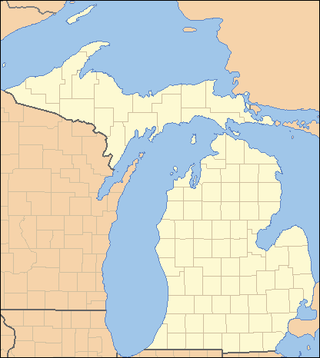
This is a list of properties on the National Register of Historic Places in the U.S. state of Michigan.
This National Park Service list is complete through NPS recent listings posted August 4, 2023.

This is a list of the National Register of Historic Places listings in Emmet County, Michigan.

This is a list of the National Register of Historic Places listings in Delta County, Michigan.

This is a list of the National Register of Historic Places listings in Mackinac County, Michigan.

This is a list of the National Register of Historic Places listings in Saginaw County, Michigan.

The Grand Village of the Illinois, also called Old Kaskaskia Village, is a site significant for being the best documented historic Native American village in the Illinois River valley. It was a large agricultural and trading village of Native Americans of the Illinois confederacy, located on the north bank of the Illinois River near the present town of Utica, Illinois. French explorers Louis Joliet and Father Jacques Marquette came across it in 1673. The Kaskaskia, a tribe of the Illiniwek people lived in the village. It grew rapidly after a French mission and fur trading post were established there in 1675, to a population of about 6,000 people in about 460 houses. Around 1691 the Kaskaskia and other Illiniwek moved further south, abandoning the site due to pressure from an Iroquois invasion from the northeast.
The Spring Creek site (20MU3) is a significant archaeological site in the U.S. state of Michigan. Located in Muskegon County in the western portion of the Lower Peninsula, it is the type site for a certain type of Late Woodland period pottery produced by the Ottawa tribe.

The Holcombe Site, also known as Holcombe Beach, is a Paleo-Indian archaeological site located near the intersection of Metropolitan Parkway and Dodge Park Road in Sterling Heights, Michigan, United States. It was listed on the National Register of Historic Places in 1971 and designated a Michigan State Historic Site in 1970.
The Sand Point Site is an archaeological site located near Baraga, Michigan. It was listed on the National Register of Historic Places in 1973.

The Summer Island site, designated 20DE4, is an archaeological site located on the northwest side of Summer Island, in Delta County, Michigan. It is classified as a stratified, multi-component site with Middle Woodland, Upper Mississippian and Early Historic/Protohistoric occupations. It was listed on the National Register of Historic Places in 1971.
The Winter Site is an archaeological site located along Big Bay de Noc north of Garden, Michigan. It was listed on the National Register of Historic Places in 1976.

The Juntunen site, also known as 20MK1, is a stratified prehistoric Late Woodland fishing village located on the western tip of Bois Blanc Island. It was listed on the National Register of Historic Places in 1978.

The Marquette Street Archaeological District is an archaeological site in St. Ignace, Michigan near the St. Ignace Mission. It covers 6 acres (2.4 ha) and includes one building, a village site, and a cemetery; archaeological designations are 20MK82 and 20MK99. It was listed on the National Register of Historic Places in 1982.
The Conservation Park Site, also known as the Pine River Park Site and designated 20GR33, is an archaeological site located along the Pine River in Alma, Michigan. The site was discovered by archaeologists from Alma College in 1976, and excavations conducted in 1977-81 and 1983-85 found early Woodland period material. indicating a camp covering 1.4 acres (0.57 ha). The site was listed on the National Register of Historic Places in 1985.

The Platte River Campground Site, designated 20BZ16, is an archaeological site located along the Platte River, within the Sleeping Bear Dunes National Lakeshore near Empire, Michigan. It is significant as a largely intact record of prehistoric life over a long span of time. It was listed on the National Register of Historic Places in 1990.

The Spoonville site, also designated 20OT1, is a historic archeological site, located on the banks of the Grand River in Crockery Township, Ottawa County, Michigan, United States. It was placed on the National Register of Historic Places in 1973.
The Gooseneck Lake IV Site, also designated 20DE44 , is an archaeological site located in Delta County, Michigan. The site dates from the Woodland period. It was listed on the National Register of Historic Places in 2014.

The Hacklander Site, also designated 20AE78, is an archaeological site located on the south shore of the Kalamazoo River east of Douglas, Michigan. It was added to the National Register of Historic Places in 1973. The site is significant because it represents much of what is understood about Woodland period life in the region.

The Charlevoix City Park Site is an archaeological site located between Bridge Street and Round Lake in Charlevoix, Michigan. It was listed on the National Register of Historic Places in 1972.
The Clark–Stringham site, designated 20-JA-37, is an archaeological site located near Jackson, Michigan. It was listed on the National Register of Historic Places in 1973.















